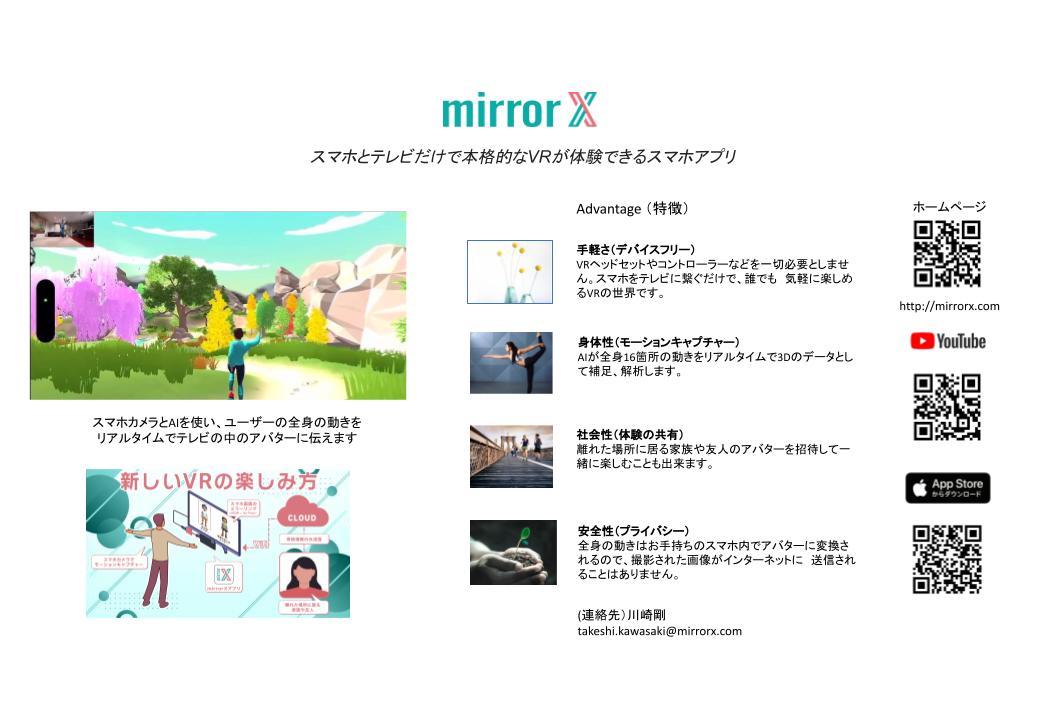Mr. Takeshi Kawasaki, CEO of mirrorX Inc.

What if you could enjoy the metaverse more easily without using a VR headset or controllers? mirrorX Inc. is developing a virtual reality (VR) app that allows users to experience virtual spaces by simply connecting their smartphone to a television. We interviewed Mr. Takeshi Kawasaki, who founded mirrorX Inc. in 2021 after working at tech companies including Sony, Amazon, and Google.
―VR usually requires a headset, controller, and other special equipment, right??
That’s usually right. Our system is the world’s first that allows users to enjoy a full-fledged virtual space just using a smartphone and TV. VR headsets are heavy and uncomfortable, and there’s also the problem of VR sickness. These have been big obstacles for people to experience and enjoy VR. So we looked for a way to make VR simpler and more practical, and eventually developed our system. It, however, took a lot more time and effort than expected because it was something nobody had ever done before. A demo version of the app is now available on the App Store.
―I heard that you worked for tech companies before starting mirrorX Inc.
I had been involved in developing new services and new products for many years. The company I worked at for the longest time was Sony. My most memorable time there was when our team launched a PC called VAIO in 1997. As a member of the team, I was in charge of product planning. After that, I worked for some foreign companies. At amazon, I was a director in charge of amazon devices in Japan which included an AI speaker called amazon Echo. At Google, I was a director managing the payment team for the Google Play Store in Japan.
―Did you start mirrorX Inc. to develop VR?
Developing a new VR system was not the objective. Rather, I started my company to apply new technology to help create an aging society where seniors can stay fit, healthy and independent, without a need for nursing care. To begin with, we are planning an exercise app for the prevention of frailty (the middle stage of the transition from healthy to a level of weakness requiring nursing care) for middle-aged and older people. This will also help reduce risks of dementia. Specifically, we are working on an app that combines walking and VR.
―Do you mean your app allows users to walk around a VR world?
Yes, we call it “virtual walking.” Users can explore virtual space with their own feet. All they have to do is connect their smartphone with the app installed to a television and “walk in place”, doing high knees. So it’s very easy. There is no need to use any of the annoying and expensive specialized equipment like a VR headset or controllers. Users are also free from VR sickness, a symptom similar to car sickness. In addition, users can exercise safely because they can see the physical space around them and can quickly notice when there is something lying on the floor.
―It sounds like a huge breakthrough. Please tell us how it works.
AI captures the user’s full body motion using the smartphone camera. Motion data is sent to a game engine where it is applied to an avatar in real time. With conventional VR, users had to wear multiple sensors called trackers on their elbows, waist, knees, and ankles to capture their body motion. Our system eliminates the need for these sensors. It’s a device-free system that allows anyone to easily enjoy VR.
―It seems very simple and convenient since it doesn’t require any dedicated devices.
Ease of use is the biggest advantage. Other features include full motion capture, allowing the avatar to mirror the user’s full body motion. There is also a social feature where users can invite the avatars of distant family and friends to the same space. Security is another advantage since we convert the motion data locally and there is no need to transmit the original images online.
―Is it easy to use for even seniors?
We have developed an UI (user interface) that can be operated by simple gestures. For example, the menu screen appears when you raise both hands. Twist your upper body left or right to rotate the icon buttons. Raise your right hand to activate the button in the center, which allows you to execute various commands and programs. Controlling your avatar is also simple: walk in place (lift knees) to move forward, twist your torso to change direction.

―It seems that exercising while watching an on-screen avatar has something in common with Nintendo Switch’s fitness software, RingFit Adventure.
Similar application but RingFit can only track body movements in 2 places: one leg with a leg band on the thigh and a Ring-Con held with the hands. In other words, it provides a programmed response with pre-generated CG (computer graphics) based on just 2 motions. So the CG you see is not the true movement of the user. If the player falls down, their avatar on RingFit is still standing. In contrast, since our app detects the movements of 16 parts throughout the body, the player’s avatar will also fall down. Also, since RingFit only displays a 2D world, it doesn’t allow users to move around the virtual space with 360 degree freedom.
―I see, so there are actually a lot of differences. Is it because of expandability that you focus on 3D instead of 2D?
Yes, it is. As long as the amount of 3D data is within the processing capacity of a smartphone, our app could, for example, link with a digital twin world or allow users to enjoy virtual travel. There are likely to be many possibilities and usage for this app in the future. It could also allow users to invite their family and friends to the same 3D space to walk and explore the virtual space together.
―What’s your intention in combining walking and VR?
As the aging population grows, it’s said that there are more than 6 million patients with dementia in Japan today. Dementia is almost irreversible once it develops, and there is no fundamentally effective treatment for it because drugs only slow its progression. Dementia is a condition that starts quietly in one’s 40s or 50s and whose early detection is difficult.
A large follow-up study in the UK, however, found that walking just 3800 steps a day reduced the risk of developing dementia by 25%, and walking 9800 steps reduced the risk by 50% (*1). In addition, a recent controlled trial conducted at the University of Tokyo that used VR for elderly people to experience virtual travel showed an improvement in visuospatial ability that contribute to the prevention of dementia (*2). We considered that the combination of walking and VR could maximize the preventative effect.
―Like you said, your system would make exercise easier for those who have difficulty going out.
It’s not a question of which is better if you’re comparing it to a walk outdoors. Rather, we’d like people to use our system on days when, for example, they are too busy to go out or the climate and weather are not suitable for a walk. Our goal is that a combination of the two will increase the overall amount of exercise and daily steps. Incidentally, walking in place (high knees) is actually more physically demanding than walking, as you lift your legs higher. It’s a very simple and effective exercise to train and increase leg muscles. If you do it seriously for 20 to 30 minutes, you’ll get sweaty.
―If the exercise load is that high, it must also have its own health benefits. How do you plan to develop your business in the future?
I’m considering a business model in which we cooperate with health insurance associations or insurance companies that are working to promote health management and a healthy life expectancy. We will also develop functions such as inviting avatars and issuing points based on the amount of exercise performed. So, we are looking for partners such as companies and venture capital firms who can work together with us on the development and social implementation of this app as well as research institutions who can conduct comparative studies with us to verify the hypothesis that combining VR and walking would maximize the preventive effect on dementia.
*1 https://jamanetwork.com/journals/jamaneurology/fullarticle/2795819
“Association of Daily Step Count and Intensity With Incident Dementia in 78 430 Adults Living in the UK”
(JAMA Intern Med. 2023; 183(2):170-171. doi: 10.1001/jamainternmed.2022.6004)
*2 ”Visuospatial Abilities and Cervical Spine Range of Motion Improvement Effects of a Non-Goal-Oriented VR Travel Program at an Older adults Facility: A Pilot Randomized Controlled Trial” (Augmented Humans 2023)
| Company name:mirrorX Inc. |
| Founded:May 2021 |
| Number of employees:5 (including contract employees) |
| Main business:Developing a VR app that allows users to enjoy VR only with a smartphone and a television URL:http://mirrorx.com |
This article is part of a series of articles introducing venture companies working together as ICF members to resolve societal issues.





